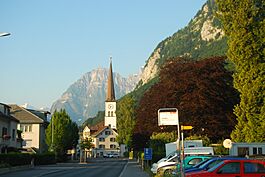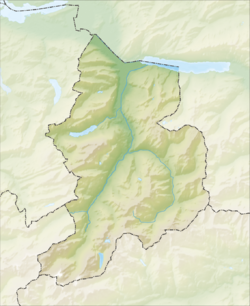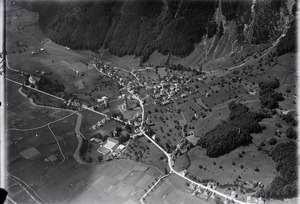Oberurnen facts for kids
Quick facts for kids
Oberurnen
|
||
|---|---|---|
 |
||
|
||
| Country | Switzerland | |
| Canton | Glarus | |
| District | n.a. | |
| Area | ||
| • Total | 12.82 km2 (4.95 sq mi) | |
| Elevation | 430 m (1,410 ft) | |
| Population
(December 2020)
|
||
| • Total | 1,963 | |
| • Density | 153.12/km2 (396.58/sq mi) | |
| Postal code |
8868
|
|
| Surrounded by | Innerthal (SZ), Mollis, Näfels, Niederurnen, Schübelbach (SZ) | |
Oberurnen was once a separate town, or municipality, in the canton of Glarus in Switzerland. Since January 1, 2011, it has become part of a larger town called Glarus Nord.
Contents
A Look at Oberurnen's Past
Oberurnen is quite old! The first time it was ever written about was in the year 1340. Back then, it was called Obern Urannen.
Exploring Oberurnen's Geography
Oberurnen covers an area of about 12.8 square kilometers (about 4.9 square miles). This information is from 2006.
How the Land is Used
A big part of Oberurnen's land, about 45.2%, is used for farming. Forests cover another large section, about 40.6% of the area. About 4.1% of the land has buildings or roads on it. The remaining 10.2% is made up of natural features like rivers or mountains.
Oberurnen is located in a part of the Glarus region known as the Glarner Unterland.
People and Life in Oberurnen
In 2010, Oberurnen had a population of 1,963 people. About 24.2% of the people living there in 2007 were from other countries. Over the past ten years, the population has grown a little, by about 0.5%.
Languages Spoken in Oberurnen
Most people in Oberurnen speak German, about 79.8% of the population. Italian is the second most common language, spoken by 8.2% of the people. Albanian is the third most common, spoken by 3.6%. These numbers are from 2000.
Education and Work in the Area
Many adults in Oberurnen have a good education. About 56.9% of people aged 25 to 64 have finished either a non-mandatory high school education or a higher education. This could be from a university or a special college called a Fachhochschule.
The unemployment rate in Oberurnen is low, at 2.5%. In 2005, many people worked in different types of jobs:
- 53 people worked in the primary economic sector. This means jobs like farming or forestry. There were 21 businesses in this area.
- 82 people worked in the secondary sector. These jobs involve making things, like in factories. There were 19 businesses in this sector.
- 129 people worked in the tertiary sector. These are jobs that provide services, like shops, hospitals, or schools. There were 42 businesses in this sector.
How Oberurnen's Population Has Changed
Here's a look at how the number of people living in Oberurnen has changed over many years:
| year | population |
|---|---|
| 1850 | 691 |
| 1900 | 862 |
| 1950 | 1,181 |
| 2000 | 1,811 |
Getting Around: Transport in Oberurnen
The Nieder- und Oberurnen railway station is an important stop for trains. It is located on the railway line that goes from Weesen to Linthal.
Train Services
Two different train services stop at this station:
- The Zürich S-Bahn service S25 travels between Linthal and Zürich.
- The St. Gallen S-Bahn service S6 travels between Rapperswil and Schwanden.
As of December 2023, both of these train services run once every hour. This means that between Ziegelbrücke and Schwanden, you can usually find two trains per hour.
See also
 In Spanish: Oberurnen para niños
In Spanish: Oberurnen para niños






